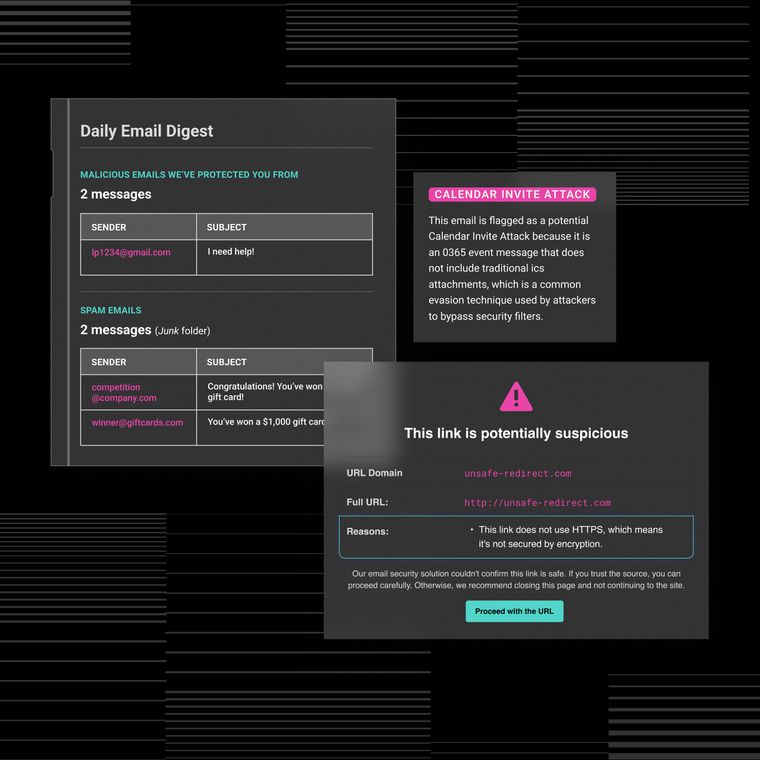The Best Practices for Implementing Advanced Threat Protection for Email
Implement advanced threat protection for email with proven best practices to safeguard against phishing, malware, and targeted attacks.
August 24, 2025
Protecting email requires a strategy that combines advanced technology, effective processes, and user awareness to counter AI-driven attacks. Email remains the primary entry point for cybercriminals, and generative AI now allows them to craft convincing messages that evade traditional filters. With malware creation accelerating, outdated spam rules are no longer sufficient against modern threats.
Building resilience requires a straightforward approach to advanced email security. Organizations should focus on selecting the right solution, integrating with existing defenses, training users to spot risks, and defining effective incident response procedures. Key practices include knowing how to act after a phishing attempt, recognizing suspicious links, and leveraging behavioral analytics to strengthen protection. The following sections outline the most effective strategies for implementing advanced threat protection for email.
Why Email Security Needs Advanced Protection
Email is still the most exploited business system because traditional filters can’t keep up with how quickly attackers innovate. Criminals now use language models, deepfakes, and zero-day malware, adapting faster than signature updates can catch them.
The sheer volume of email only adds to the challenge. Inboxes are flooded with spam, while new malware variants appear daily, overwhelming rule-based gateways. Since email is such a central communication tool, attackers continue to see it as their best way in.
Modern campaigns often center on business email compromise, vendor fraud, and account takeover. These threats rarely contain obvious signs like malicious links or attachments, so legacy filters usually let them through. Advanced, behavior-driven protection fills this gap by analyzing context, intent, and relationship patterns, keeping pace with attackers who already rely on AI.
1. Choose the Right Solution for Your Environment
Advanced threat protection platforms must deliver comprehensive detection, real-time intelligence, flexible policies, seamless integration, and detailed reporting that align with your organization's risk profile.
When evaluating solutions, focus on five critical capabilities:
Layered Detection: It combines sandboxing, URL rewriting, and behavioral analytics to catch sophisticated threats.
Real-time Threat Intelligence Feeds: These continuously update detection rules to close zero-day attack windows.
Granular Policy Controls: These allow per-user or per-department tuning, enabling more aggressive protection for high-risk teams like finance.
Native Integration: This works with your existing cloud or hybrid infrastructure without requiring architectural changes.
Detailed Reporting and Forensics: These provide context for every security decision and blocked message.
Match these security capabilities to your industry’s threat patterns and email volume. In environments with heavy traffic, speed, accuracy, and minimal false positives are equally essential. Test solutions in real conditions with phishing simulations to see how they perform across detection, latency, and operational impact.
2. Integrate with Existing Security Tools
Advanced threat protection delivers the most value when it enhances existing security investments through seamless integration. To start, connect ATP event data to your SIEM so detections correlate with network, cloud, and identity logs. By using standardized formats such as Syslog or STIX/TAXII, analysts can quickly pivot from suspicious messages to related indicators, which significantly reduces response times.
In addition, link ATP with endpoint detection to close the gap between the inbox and the device. When a malicious attachment slips past initial filters, endpoint agents can isolate the host while ATP simultaneously retracts the email from every mailbox. Through bidirectional APIs, these actions happen in coordination, maintaining both speed and accuracy while minimizing false positives.
Also, you need to automate repetitive containment steps through SOAR platforms or custom scripts. Quarantines, credential resets, and ticket creation occur automatically, lowering mean time to respond and freeing analysts to focus on advanced threat hunting.
Ultimately, proper integration transforms isolated security tools into a unified defense architecture that adapts to evolving attacks and scales with organizational needs.
3. Train Your Users to Recognize Threats
Technology alone cannot stop every attack, and the most effective email security starts with people. When employees are trained to identify and report suspicious messages, they close the gap that filters may miss.
Build Role-Based Training Programs
Training should be risk-based, continuous, and relevant. Tailor content to each team’s exposure: finance teams practice wire-fraud scenarios, while developers focus on credential-phishing lures. Reinforce learning through monthly phishing simulations with varied payloads, ensuring employees face realistic threats tied to their daily work.
Establish Clear Reporting Procedures
Training only works when employees know how to act. Standardize a one-click reporting process and practice it regularly. Remember, clear escalation paths ensure your security team hears about malicious emails within minutes.
Track Performance and Optimize
Evaluate training with three key metrics: click-through rates on simulations, report rates for real threats, and median reporting time. Review quarterly and adjust content as needed to maintain progress.
When employees are trained effectively, they become a true first line of defense, complementing technical controls and strengthening your organization’s overall resilience.
4. Establish Clear Incident Response Procedures
Effective incident response for email threats requires structured playbooks tailored to the unique risks of phishing, business email compromise, and other email-borne attacks. Strong procedures should define roles and responsibilities, outline escalation paths, and incorporate automation to contain threats quickly.
Develop step-by-step protocols for different scenarios so every team member knows their role during an incident. Automated detection and remediation tools should handle routine containment, reducing the need for manual intervention and accelerating recovery.
Post-incident analysis is equally important. Reviewing each case helps uncover vulnerabilities, evaluate the effectiveness of response actions, and strengthen future strategies.
Additionally, clear communication during incidents builds trust and ensures smooth coordination. Internal teams and external stakeholders should receive timely updates and transparent reporting. Regular training exercises, including tabletop simulations, validate response plans and prepare teams to act decisively under pressure.
5. Continuously Monitor and Tune Your Protection
Email threats evolve daily, and static defenses quickly lose effectiveness. Advanced threat protection remains effective only when organizations commit to ongoing measurement and refinement. Without this process, false positives frustrate users, true threats slip through, and security teams fall behind.
Track Key Metrics
Focus on detection efficacy, false positive rate, mean time to remediate, and user-reported misses. Maintaining a high signal-to-noise ratio is essential because excessive quarantines erode trust and slow business operations.
Correlate attack spikes with policy changes or new campaigns, then validate that adjustments reduce false positives without introducing gaps. Hold monthly reviews with operations teams and document progress to tie improvements directly to actions.
Automate Tuning with Behavioral Analytics
Manual rule updates cannot keep pace with AI-driven phishing or deepfake business email compromise. Behavioral analytics establishes baselines of normal communication and surface anomalies that static rules miss.
Modern tools ingest live threat intelligence, cross-tenant insights, and content signals to adjust detection models within hours, ensuring defenses adapt as quickly as attackers.
Balance Automation with Human Oversight
Pair self-optimizing capabilities with quarterly threat hunting sessions to ensure automation aligns with organizational risk tolerance. Feed results into your SIEM for unified visibility across endpoints, networks, and email. Keep security teams aligned with concise updates on emerging attack methods and changes to detection models.
How Abnormal AI Enhances Email Threat Protection
Abnormal strengthens email security by using behavioral AI to understand normal communication patterns and spot even subtle deviations. Once connected via API, the platform ingests thousands of identity, content, and context signals from Microsoft 365 or Google Workspace to establish baselines for every user, vendor, and workflow.
This continuous learning detects advanced threats that often lack malicious links or attachments. Sudden shifts, such as unusual login locations, atypical requests, or broken communication patterns, trigger immediate investigation.
Unlike rule-based gateways, Abnormal operates beyond static signatures, surfacing attacks that others miss. Dashboards provide clear explanations of anomalies, showing which factors influenced detection. Confirmed threats are automatically removed from all inboxes, timelines are updated, and security teams are notified, reducing manual workloads and cutting false positives. Integration with SIEM and SOAR tools takes minutes, and remediation policies can be easily tuned without writing rules.
Behavioral AI delivers proactive defense against sophisticated social engineering, restores confidence in email, and scales security without disruption. Book a demo to see how Abnormal can protect your organization.
Related Posts
Get the Latest Email Security Insights
Subscribe to our newsletter to receive updates on the latest attacks and new trends in the email threat landscape.


